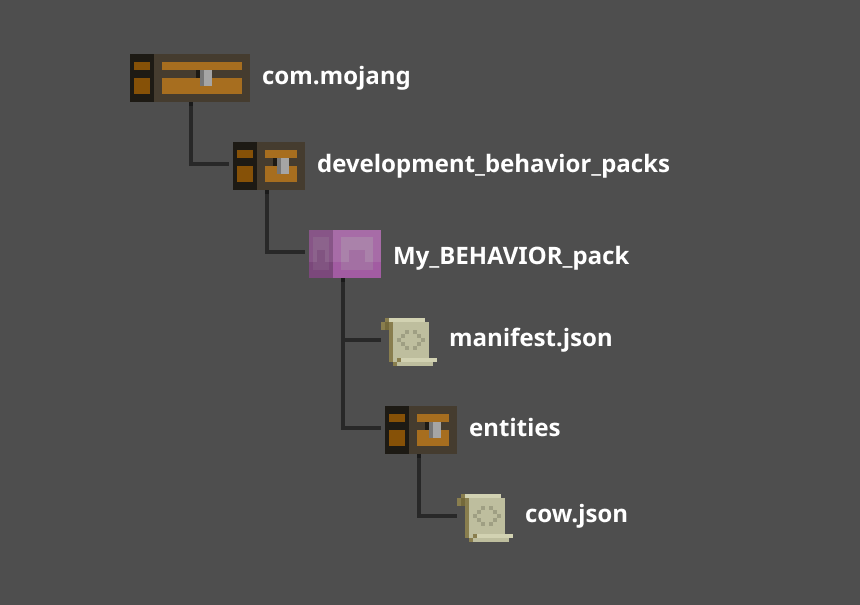Note
Access to this page requires authorization. You can try signing in or changing directories.
Access to this page requires authorization. You can try changing directories.
Entity behavior components are one of the specific ways we can use components to get entities to behave a certain way. Behavior components determine how entities decide how to act in the game by controlling how they move, interact with objects or other entities, or respond to certain events. Here are some key points to keep in mind:
- Behavior components are defined in
.jsonfiles as part of a behavior pack. - Behavior components start with
minecraft:behavior.. - Minecraft Bedrock edition includes many built-in behavior components. For a full list, see Entity Documentation - AI Goal Component List.
- Many behavior components accept parameters to fine-tune an entity's actions or responses to events, such as
speed_multiplierortarget_distance.
Behavior Components Structure
As part of a behavior pack, behavior components are defined within an entity's .json file inside the behavior pack folder. Here is an example of the structure of a behavior pack:

Behavior Priority
Behavior components are evaluated independently, which means that different behaviors might be evaluated simultaneously. This can either help to create a seamless behavior, where two harmonious actions are performed at the same time, or it can cause two incompatible behaviors to compete. In the case where incompatible behaviors compete, you may see errors or notice that your entity's behaviors don't work in the way you expect.
To resolve this issue, it's important to know that behavior components work on a priority system. Behavior components with a lower priority value are executed first - so a component with a priority of 1 would execute before a component with a priority of 2. Behavior components also resolve on the same priority, meaning that, even if a component with a higher priority value meets the conditions for execution, the component with the lower priority value would resolve first before the next component is allowed to start. This helps to create a sequence of behaviors and seamless switching between behaviors.
Adding Custom Behavior
For a complete tutorial on adding custom behavior, check out the Create an Angry Cow: An Introduction To Behavior Packs (from scratch) guide. This will help you get an understanding of how to add components to an entity's .json file, where to add the code, and how to test and deploy your behavior pack. Pay close attention to the final angry cow components list to make sure you see how priority will affect the custom entity's behavior:
"minecraft:behavior.nearest_attackable_target": {
"priority": 2,
"must_see": true,
"reselect_targets": true,
"within_radius": 25.0,
"entity_types": [
{
"filters": {
"test": "is_family",
"subject": "other",
"value": "player"
},
"max_dist": 32
}
]
},
"minecraft:behavior.melee_attack": {
"priority": 3
},
"minecraft:attack": {
"damage": 3
}
See how minecraft:behavior.nearest_attackable_target has a lower priority value than the minecraft:behavior.melee_attack component? That's because we want to target only attackable entities that are not cows. If we didn't have the priorities set the way we do, then the cow may attack indiscriminantly or might try attacking things that don't take damage, causing it to get stuck in a loop.
Essential Behavior Components
Now that you know how to add behavior components and design custom behavior, let's take a look at some of the most important behavior components in Minecraft. While Minecraft does not have "required" components, there are some - like minecraft:movement, minecraft:health, and minecraft:interact that are essential to an entity's ability to have a meaningful impact on your world. Behavior components are similar. There are no requirements for behavior components, but there are definitely some behaviors that are extremely common and give entities a "baseline" ability to interact with the world, with other entities, and with players. Here's a list of some of the most common entity behaviors:
| Behavior | Purpose | Common Users |
|---|---|---|
| minecraft:behavior.look_at_player | Makes the entity look at a player. | Passive mobs, neutral mobs |
| minecraft:behavior.random_stroll | Makes an entity wander around in a random path. | Passive mobs |
| minecraft:behavior.nearest_attackable_target | Targets the nearest entity to attack. | Hostile mobs |
| minecraft:behavior.attack | Defines how the entity attacks its target. | Hostile mobs |
| minecraft:behavior.hurt_by_target | Makes the entity retaliate when it is hurt. | Passive mobs, hostile mobs |
| minecraft:behavior.breed | Enables breeding for an entity. | Passive mobs |
| minecraft:behavior.follow_owner | Makes an entity follow its owner. | Tamed mobs |
| minecraft:behavior.sit | Makes an entity sit on command. | Tamed mobs |